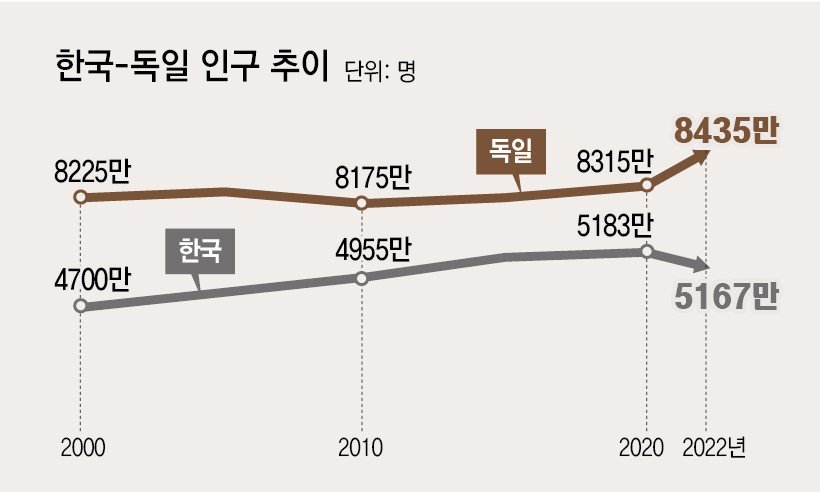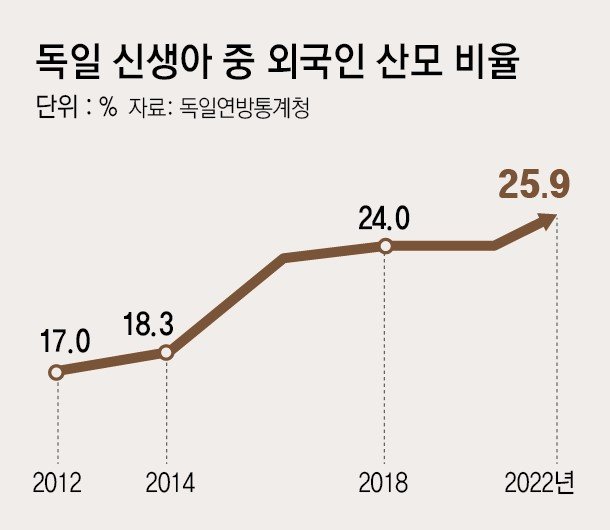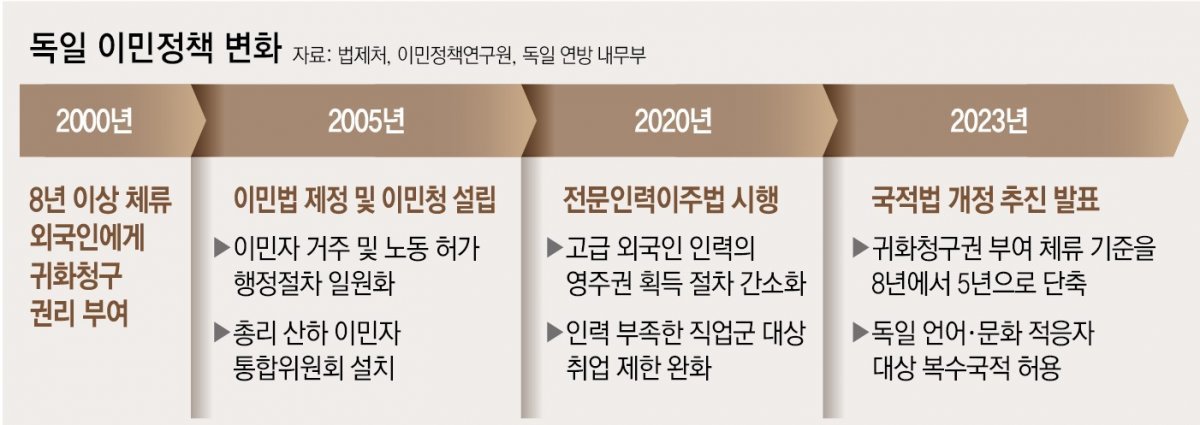[출산율, 다시 ‘1.0대’로]
Part 1 Countries that achieved a rebound in birth rates〈4〉 Korea lowered the immigration threshold and raised birthrates
Immigration was opened in 2005 due to a manpower shortage… Former national qualifications and degrees are recognized
Free language education for immigrant children… Immigrant birth rate, 25% of the population, is 1.88.
《The secret to the male birth rate ‘1.25 → 1.46’
Germany, the most populous country in the European Union (EU), suffered from a labor shortage due to chronic low birth rates until the 1990s. Chancellor Angela Merkel accepted the demands of the industry and implemented an active immigration policy immediately after taking office in 2005. At the same time, she strengthened support for childbirth and childcare, raising the total fertility rate from 1.25 in 1995 to 1.46 in 2022. We looked at how Germany, which is preparing for an era with a population of 90 million, overcame its low birth rate.》

At 4pm on the 9th (local time), ‘Eco Kita 5’, a public kindergarten located in Offenbach, Hesse, Germany.
Not only German but also various languages were heard among the children playing together. Employee Solano Ortega (31) explained, “Offenbach is an area with many immigrants, so there are not only children from Germany, but also children from Asia, Eastern Europe, and Arab countries.” He added, “23 out of 25 children in the 3 to 6-year-old class are immigrant children.” did.
This kindergarten is staffed with language education experts to help immigrant children learn German. Mr. Ortega said, “All processes, including child psychological counseling, are provided free of charge to immigrant children.”
Germany, which maintains the largest population in the European Union (EU), is considered successful in lowering the immigration threshold and reviving the birth rate. Germany’s total fertility rate was 1.25 in 1995, less than 80% of Korea’s (1.63), but it rose by nearly 20% to 1.46 in 2022, nearly twice that of Korea (0.78). In 2022, one in four people in Germany will be foreigners or immigrants, and their average total fertility rate will reach 1.88.
Germany achieved economic growth called the ‘Miracle on the Rhine’ after World War II, but suffered from a labor shortage due to worsening low birth rates since the 1970s. Countries such as Turkuye and Korea accepted foreign workers, but efforts to absorb them into society were insufficient.
Due to a labor shortage, the population did not exceed the threshold of 80 million, and after unification in 1990, a large number of single women from East Germany fled to West Germany, causing the birth rate in East Germany to drop to 0.77. Eventually, Chancellor Angela Merkel, who took office in 2005, accepted the industry’s demand for immigration and began implementing an active immigration policy. Although there were many voices opposing her, citing ‘Germanic bloodism,’ Prime Minister Merkel steadily persuaded her, saying, “The country always benefits economically and socially from successful immigration.”
The Immigration Act enacted in 2005 significantly lowered Germany’s immigration threshold. An immigration office was created and immigration was opened regardless of occupation. Immigrants and their children were granted the same welfare benefits as those from Germany, and immigrant settlement policies such as vocational training were also established. Andreas Edel, a researcher at the Max Planck Institute for Population Research, explained, “Policies to lower the immigration threshold have continued since the enactment of the Immigration Act, such as recognizing the qualifications and degrees acquired by immigrants in their previous countries and allowing them to easily access the labor market.”
As a result, Germany’s population began to rise again, reaching 84.35 million in 2022. Chancellor Olaf Scholz expressed confidence in his ‘Citizen Dialogue’ last December, saying, “According to the National Statistical Office, Germany’s population will soon reach 90 million.”

Between 2004 and 2007, before and after the enactment of the Immigration Act, the German government successively introduced policies to strengthen childbirth and childcare support to resolve the low birth rate problem. These benefits were also provided to immigrant children. The annual cost of supporting language education in public kindergartens for immigrant children to acquire German amounts to approximately 100 million euros (approximately 145 billion won).
The recently introduced child care support measures do not include content related to migrant children.
Last year, the German government announced that it would invest 4 billion euros (about 5.82 trillion won) over two years to support the opening of about 35,000 public kindergartens that provide care from 4 to 5 p.m. for children of office workers. It also includes 312 million euros (about 452 billion won) in support for children of migrant families.
In addition, about 3.5 billion euros (approximately 5 trillion won) over 4 years will be invested in ‘full-time schools’, where students in grades 5 to 10, equivalent to the upper grades of elementary school to middle school in Korea, can attend classes until 4 or 5 p.m. after completing regular classes. was invested, and programs for immigrant families were also heavily included.
Researcher Edel said, “The purpose of education for immigrant children, including German language education, is to help them advance into the labor market in the future and help national competitiveness,” adding, “Especially during the spread of the novel coronavirus infection (COVID-19), we are focusing the budget on strengthening language education for immigrant children.” “I did it,” he said.
German companies supported government policies by expanding in-house facilities such as kindergartens and daycare centers to allow married people to work and raise children at the same time.
For example, global pharmaceutical company Bayer spends 6 million euros (approximately 8.6 billion won) annually to run an in-house kindergarten. Miriam Brombach (53), a Bayer family policy manager who met in Leverkusen, North Rhine-Westphalia on the 10th, said, “The in-house kindergarten is equipped with performance facilities and an artificial rock climbing wall, so it is highly preferred by employees.” “Based on the judgment that it would increase productivity, we made it available not only to Bayer employees but also to employees of partner companies,” he said. He also said, “Now, an atmosphere has been created within the company where employees can easily miss executive meetings when their children are sick.”
Offenbach·Leverkusen=
Source: Donga
Mark Jones is a world traveler and journalist for News Rebeat. With a curious mind and a love of adventure, Mark brings a unique perspective to the latest global events and provides in-depth and thought-provoking coverage of the world at large.
